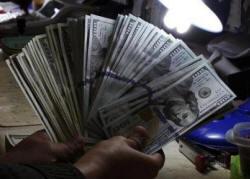|
 Dollar
hurting post-Fed, Norwegian crown sinks Dollar
hurting post-Fed, Norwegian crown sinks
 Send a link to a friend
Send a link to a friend
[June 19, 2014] By
Patrick Graham
LONDON (Reuters) - A U-turn on interest rate
policy in Norway drove a wipeout for its currency on
Thursday, coloring a session marked mainly by
disappointment over the Federal Reserve's failure to
propel the dollar higher.
|
|
 The U.S. currency hit a three-week low against a basket of
currencies in Asian time and was at its lowest in 10 days against
the euro. Sterling inched up to a new five-year high of $1.7029. The U.S. currency hit a three-week low against a basket of
currencies in Asian time and was at its lowest in 10 days against
the euro. Sterling inched up to a new five-year high of $1.7029.
But it was the action on the Norwegian crown market that dominated
the European session. It sank to a two-month low in 2 minutes of
manic trading after the central bank overturned expectations of
higher interest rates next year, warning that if anything it might
have to cut borrowing costs.
"A lot of people have been absolutely done by this morning and there
was nothing they could do," said one London-based dealer. "It was
carnage."
The crown sank, with the euro jumping 1.5 percent against the
Norwegian currency in high trading volumes, to 8.3230 crowns from
around 8.1772 crowns beforehand. That was the crown's weakest since
late April and put the single currency on track for its biggest
daily rise since mid-September.

The central bank's move was prompted mainly by cuts in planned
spending by oil companies for next year but comes as oil-rich Norway
eyes the impact of a week of fighting in Iraq that has driven oil
prices close to $120 a barrel.
Josh O'Byrne, a currency strategist with Citi in London, said he
doubted the central bank would be able to be as sanguine about
inflation over the next three years as its forecasts on Thursday
suggested.
"In 2016 they now see just one 25 basis point move and then a second
in 2017, adding up to just 50 basis points in some three years," he
said.
FED DISAPPOINTS
The Norwegian crown fell against the dollar too <NOK=>, despite the
greenback struggling broadly.
New projections suggested the Fed saw rates rising more in 2015 and
2016 than it had previously forecast, but officials lowered their
long-term rate target and its overall tone stopped well short of the
hawkish drift some traders had expected.
That sharpened the divergence in the respective timetables for the
Fed and the Bank of England raising interest rates. The British
bank's officials have spent the past week making clear there is some
risk rates could even rise this year while Janet Yellen's main
emphasis seemed to be a slight decline in longer-term growth
projections.
"There were those speculating that the Fed would have to come up
with a more hawkish commentary and obviously they have been
disappointed," said Neil Mellor, a strategist with Bank of New York
Mellon in London.

[to top of second column] |

"Nothing has really changed from the past few days, so there will be
a propensity to buy some euros, and probably sterling in lock-step
with that."
U.S. Treasury yields fell, with the benchmark 10-year rate dropping
to 2.582 percent from the U.S. close of 2.615 percent.
The dollar index traded at its lowest since May 27, down almost 0.5
percent on the day at 80.23. Against the euro it was almost a cent
weaker than a day earlier, down 0.3 percent compared to Wednesday's
U.S. close.
CLOUD
A further rise in oil prices underlined that investors remain deeply
concerned by events in Iraq [O/R]. The resulting search for safe
havens for their money was underpinning traditionally safe bets like
the yen, dollar and Swiss franc.
The franc inched up to a session high of 1.21665 francs per euro
after the Swiss National Bank kept all of its policy parameters
steady.
The yen was just over 0.1 percent higher against the dollar in early
European trade, trading at 101.78 yen versus a one-week high of
102.38 yen before the Fed's announcement. The euro was slightly
lower at $1.3589 after it touched $1.3600 on Wednesday.

Commodity currencies fared particularly well against the dollar
after the Fed announcement, with the New Zealand currency rallying
nearly 1 percent to six-week highs of $0.8736. It was last down 0.1
percent from those highs at $0.8713. On a trade-weighted basis, the
kiwi rose to a record high of 81.30.
(Additional reporting by Anirban Nag; Editing by Catherine Evans)
[© 2014 Thomson Reuters. All rights
reserved.] Copyright
2014 Reuters. All rights reserved. This material may not be
published, broadcast, rewritten or redistributed. |